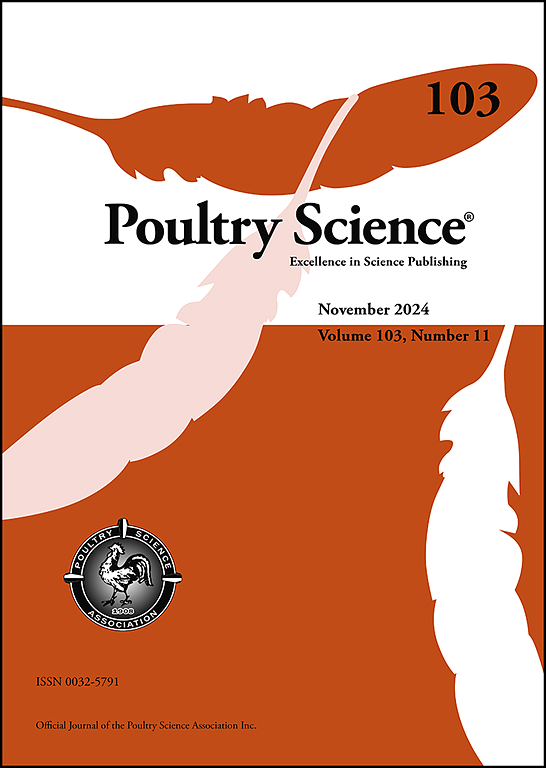Effect of Inhalation Application of Lavender Essential Oil on Slaughter and Carcass Characteristics and Serum Biochemistry in Texas Quail
IF 3.8
1区 农林科学
Q1 AGRICULTURE, DAIRY & ANIMAL SCIENCE
引用次数: 0
Abstract
The aim of this study is to determine the effect of the lavender essential oil inhalation on slaughter and carcass characteristics and biochemical parameters of Texas quails. The material of the study consisted of 72 Texas quails aged between 28-42 days and the application was carried out in a 2x2 trial set-up. Inhalation application was carried out in the 4x4 m poultry breeding rooms in the Alternative Poultry Unit at the Prof. Dr. Hümeyra Özgen Research and Application Farm. Lavender essential oil, extracted by distillation, was applied to Texas Quails at solution of 0.1% concentration for 1 hour per day for 14 days. A total of 12 quails,including 3 females and 3 males from each group, were slaughtered at the age of 42 days and their slaughter and carcass characteristics were determined. Serum biochemistry values were determined with blood samples taken from the quails during slaughter. As a result of the study, it was determined that the inhalation method did not affect the slaughter and carcass characteristics of 28–42 day-old Texas quails, but it had a reducing effect on HDL, triglyceride, and glucose values, which indicate lipid and carbohydrate metabolism, among the serum biochemistry values examined. Considering the positive effects of the inhalation of lavender essential oil on animal health, it is recommended to conduct more comprehensive studies.
本研究旨在确定吸入薰衣草精油对德克萨斯鹌鹑屠宰和胴体特征及生化参数的影响。研究材料包括 72 只年龄在 28-42 天之间的德克萨斯鹌鹑,应用采用 2x2 试验装置。吸入试验在 Hümeyra Özgen 教授研究与应用农场替代家禽部的 4x4 m 家禽饲养室中进行。将蒸馏提取的薰衣草精油涂抹在德克萨斯鹌鹑身上,溶液浓度为 0.1%,每天 1 小时,持续 14 天。在鹌鹑42日龄时屠宰12只鹌鹑,每组包括3只雌性和3只雄性鹌鹑,并测定它们的屠宰和胴体特征。在屠宰过程中,对鹌鹑的血液样本进行了血清生化值测定。研究结果表明,吸入法对 28-42 日龄德克萨斯鹌鹑的屠宰和胴体特征没有影响,但在所检测的血清生化值中,吸入法对表示脂质和碳水化合物代谢的高密度脂蛋白、甘油三酯和葡萄糖值有降低作用。考虑到吸入薰衣草精油对动物健康的积极影响,建议进行更全面的研究。
本文章由计算机程序翻译,如有差异,请以英文原文为准。
求助全文
约1分钟内获得全文
求助全文
来源期刊

Poultry Science
农林科学-奶制品与动物科学
CiteScore
7.60
自引率
15.90%
发文量
0
审稿时长
94 days
期刊介绍:
First self-published in 1921, Poultry Science is an internationally renowned monthly journal, known as the authoritative source for a broad range of poultry information and high-caliber research. The journal plays a pivotal role in the dissemination of preeminent poultry-related knowledge across all disciplines. As of January 2020, Poultry Science will become an Open Access journal with no subscription charges, meaning authors who publish here can make their research immediately, permanently, and freely accessible worldwide while retaining copyright to their work. Papers submitted for publication after October 1, 2019 will be published as Open Access papers.
An international journal, Poultry Science publishes original papers, research notes, symposium papers, and reviews of basic science as applied to poultry. This authoritative source of poultry information is consistently ranked by ISI Impact Factor as one of the top 10 agriculture, dairy and animal science journals to deliver high-caliber research. Currently it is the highest-ranked (by Impact Factor and Eigenfactor) journal dedicated to publishing poultry research. Subject areas include breeding, genetics, education, production, management, environment, health, behavior, welfare, immunology, molecular biology, metabolism, nutrition, physiology, reproduction, processing, and products.
 求助内容:
求助内容: 应助结果提醒方式:
应助结果提醒方式:


